纪念柏林墙倒塌(英语版)
- 格式:doc
- 大小:86.50 KB
- 文档页数:2
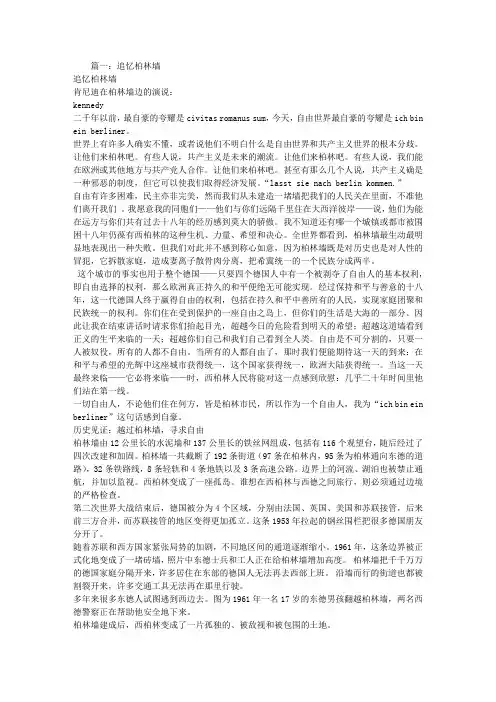
篇一:追忆柏林墙追忆柏林墙肯尼迪在柏林墙边的演说:kennedy二千年以前,最自豪的夸耀是civitas romanus sum,今天,自由世界最自豪的夸耀是ich bin ein berliner。
世界上有许多人确实不懂,或者说他们不明白什么是自由世界和共产主义世界的根本分歧。
让他们来柏林吧。
有些人说,共产主义是未来的潮流。
让他们来柏林吧。
有些人说,我们能在欧洲或其他地方与共产党人合作。
让他们来柏林吧。
甚至有那么几个人说,共产主义确是一种邪恶的制度,但它可以使我们取得经济发展。
“lasst sie nach berlin kommen.”自由有许多困难,民主亦非完美,然而我们从未建造一堵墙把我们的人民关在里面,不准他们离开我们。
我愿意我的同胞们——他们与你们远隔千里住在大西洋彼岸——说,他们为能在远方与你们共有过去十八年的经历感到莫大的骄傲。
我不知道还有哪一个城镇或都市被围困十八年仍葆有西柏林的这种生机、力量、希望和决心。
全世界都看到,柏林墙最生动最明显地表现出一种失败。
但我们对此并不感到称心如意,因为柏林墙既是对历史也是对人性的冒犯,它拆散家庭,造成妻离子散骨肉分离,把希冀统一的一个民族分成两半。
这个城市的事实也用于整个德国——只要四个德国人中有一个被剥夺了自由人的基本权利,即自由选择的权利,那么欧洲真正持久的和平便绝无可能实现。
经过保持和平与善意的十八年,这一代德国人终于赢得自由的权利,包括在持久和平中善所有的人民,实现家庭团聚和民族统一的权利。
你们住在受到保护的一座自由之岛上,但你们的生活是大海的一部分。
因此让我在结束讲话时请求你们抬起目光,超越今日的危险看到明天的希望;超越这道墙看到正义的生平来临的一天;超越你们自己和我们自己看到全人类。
自由是不可分割的,只要一人被奴役,所有的人都不自由。
当所有的人都自由了,那时我们便能期待这一天的到来:在和平与希望的光辉中这座城市获得统一,这个国家获得统一,欧洲大陆获得统一。
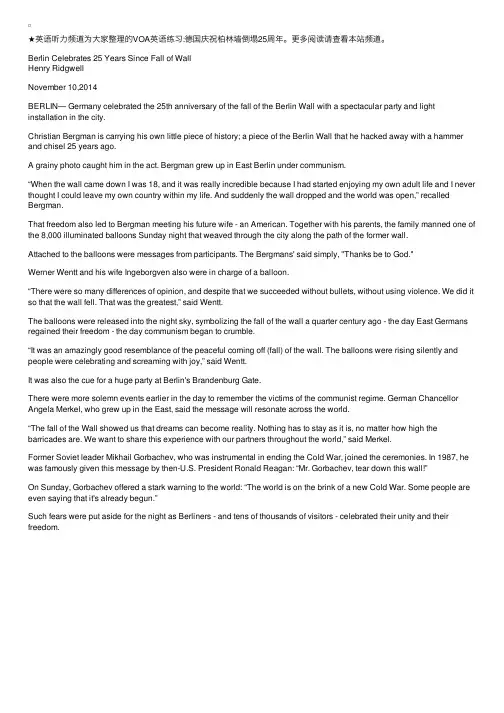
★英语听⼒频道为⼤家整理的VOA英语练习:德国庆祝柏林墙倒塌25周年。
更多阅读请查看本站频道。
Berlin Celebrates 25 Years Since Fall of WallHenry RidgwellNovember 10,2014BERLIN— Germany celebrated the 25th anniversary of the fall of the Berlin Wall with a spectacular party and light installation in the city.Christian Bergman is carrying his own little piece of history; a piece of the Berlin Wall that he hacked away with a hammer and chisel 25 years ago.A grainy photo caught him in the act. Bergman grew up in East Berlin under communism.“When the wall came down I was 18, and it was really incredible because I had started enjoying my own adult life and I never thought I could leave my own country within my life. And suddenly the wall dropped and the world was open,” recalled Bergman.That freedom also led to Bergman meeting his future wife - an American. Together with his parents, the family manned one of the 8,000 illuminated balloons Sunday night that weaved through the city along the path of the former wall.Attached to the balloons were messages from participants. The Bergmans' said simply, "Thanks be to God."Werner Wentt and his wife Ingeborgven also were in charge of a balloon.“There were so many differences of opinion, and despite that we succeeded without bullets, without using violence. We did it so that the wall fell. That was the greatest,” said Wentt.The balloons were released into the night sky, symbolizing the fall of the wall a quarter century ago - the day East Germans regained their freedom - the day communism began to crumble.“It was an amazingly good resemblance of the peaceful coming off (fall) of the wall. The balloons were rising silently and people were celebrating and screaming with joy,” said Wentt.It was also the cue for a huge party at Berlin's Brandenburg Gate.There were more solemn events earlier in the day to remember the victims of the communist regime. German Chancellor Angela Merkel, who grew up in the East, said the message will resonate across the world.“The fall of the Wall showed us that dreams can become reality. Nothing has to stay as it is, no matter how high the barricades are. We want to share this experience with our partners throughout the world,” said Merkel.Former Soviet leader Mikhail Gorbachev, who was instrumental in ending the Cold War, joined the ceremonies. In 1987, he was famously given this message by then-U.S. President Ronald Reagan: “Mr. Gorbachev, tear down this wall!”On Sunday, Gorbachev offered a stark warning to the world: “The world is on the brink of a new Cold War. Some people are even saying that it's already begun.”Such fears were put aside for the night as Berliners - and tens of thousands of visitors - celebrated their unity and their freedom.。

战争与和平历史上最重要的战争与和平协议在人类历史长河中,战争和和平交替更迭,而战争与和平协议扮演着至关重要的角色。
这些协议对于国际社会的稳定与发展具有深远的意义。
本文将介绍一些在战争与和平历史上最重要的战争与和平协议,从而使我们更好地了解这些重要事件。
一、《凡尔赛和约》(Treaty of Versailles)《凡尔赛和约》是第一次世界大战结束后,于1919年在法国凡尔赛宫签订的和平协议。
该协议以惩罚德国为主要目标,追究其对战争的起因和责任。
协议规定德国需承担巨额赔款、削减军队规模和划归领土等惩罚性条件。
然而,这些严厉的惩罚引发了德国的不满和复仇心态,间接导致了二战的爆发。
因此,该协议既有重要意义,也有一定负面影响。
二、《雅尔塔协定》(Yalta Conference)《雅尔塔协定》是第二次世界大战期间,于1945年在苏联雅尔塔举行的会议上签订的协议。
会议由美国、苏联和英国三国领导人组成,旨在规划战后欧洲的重建和重新划分势力范围。
在该协定中,各方同意将德国分为四个占领区,并就其他战后事务形成共识。
此协定确立了战后国际秩序和联合国的设立,为全球和平与稳定奠定了基础。
三、《联合国宪章》(United Nations Charter)《联合国宪章》于1945年在旧金山正式签署,标志着联合国机构的建立。
该宪章旨在维护国际和平与安全,促进国际合作和发展。
它规定了联合国的组织结构、职能和原则,并确立了成员国之间的平等和主权原则。
作为全球最重要的国际组织之一,联合国在促进和平与协作方面发挥了重要作用。
四、《波茨坦公告》(Potsdam Declaration)《波茨坦公告》是第二次世界大战结束后,于1945年在德国波茨坦签署的宣言。
该宣言由中、美、英三国领导人发布,其中包含了对日本的无条件投降要求和战后重建原则。
《波茨坦公告》的发布,为结束太平洋战争奠定了基础,确保了战后和平与稳定。
五、《柏林墙倒塌协议》(Agreement on the Final Settlement with Respect to Germany)在冷战时期,东西德民主共和国之间的分裂导致了柏林墙的建立。
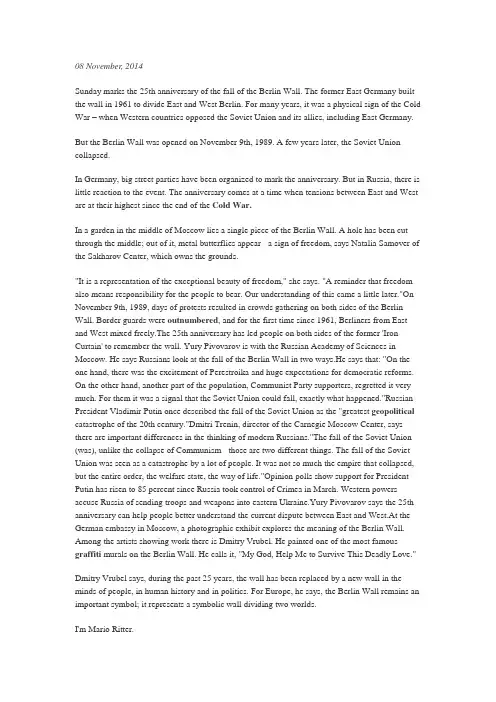
08 November, 2014Sunday marks the 25th anniversary of the fall of the Berlin Wall. The former East Germany built the wall in 1961 to divide East and West Berlin. For many years, it was a physical sign of the Cold War – when Western countries opposed the Soviet Union and its allies, including East Germany.But the Berlin Wall was opened on November 9th, 1989. A few years later, the Soviet Union collapsed.In Germany, big street parties have been organized to mark the anniversary. But in Russia, there is little reaction to the event. The anniversary comes at a time when tensions between East and West are at their highest since the end of the Cold War.In a garden in the middle of Moscow lies a single piece of the Berlin Wall. A hole has been cut through the middle; out of it, metal butterflies appear - a sign of freedom, says Natalia Samover of the Sakharov Center, which owns the grounds."It is a representation of the exceptional beauty of freedom," she says. "A reminder that freedom also means responsibility for the people to bear. Our understanding of this came a little later."On November 9th, 1989, days of protests resulted in crowds gathering on both sides of the Berlin Wall. Border guards were outnumbered, and for the first time since 1961, Berliners from East and West mixed freely.The 25th anniversary has led people on both sides of the former 'Iron Curtain' to remember the wall. Yury Pivovarov is with the Russian Academy of Sciences in Moscow. He says Russians look at the fall of the Berlin Wall in two ways.He says that: "On the one hand, there was the excitement of Perestroika and huge expectations for democratic reforms. On the other hand, another part of the population, Communist Party supporters, regretted it very much. For them it was a signal that the Soviet Union could fall, exactly what happened."Russian President Vladimir Putin once described the fall of the Soviet Union as the "greatest geopolitical catastrophe of the 20th century."Dmitri Trenin, director of the Carnegie Moscow Center, says there are important differences in the thinking of modern Russians."The fall of the Soviet Union (was), unlike the collapse of Communism - those are two different things. The fall of the Soviet Union was seen as a catastrophe by a lot of people. It was not so much the empire that collapsed, but the entire order, the welfare state, the way of life."Opinion polls show support for President Putin has risen to 85 percent since Russia took control of Crimea in March. Western powers accuse Russia of sending troops and weapons into eastern Ukraine.Yury Pivovarov says the 25th anniversary can help people better understand the current dispute between East and West.At the German embassy in Moscow, a photographic exhibit explores the meaning of the Berlin Wall. Among the artists showing work there is Dmitry Vrubel. He painted one of the most famous graffiti murals on the Berlin Wall. He calls it, "My God, Help Me to Survive This Deadly Love."Dmitry Vrubel says, during the past 25 years, the wall has been replaced by a new wall in the minds of people, in human history and in politics. For Europe, he says, the Berlin Wall remains an important symbol; it represents a symbolic wall dividing two worlds.I'm Mario Ritter.。
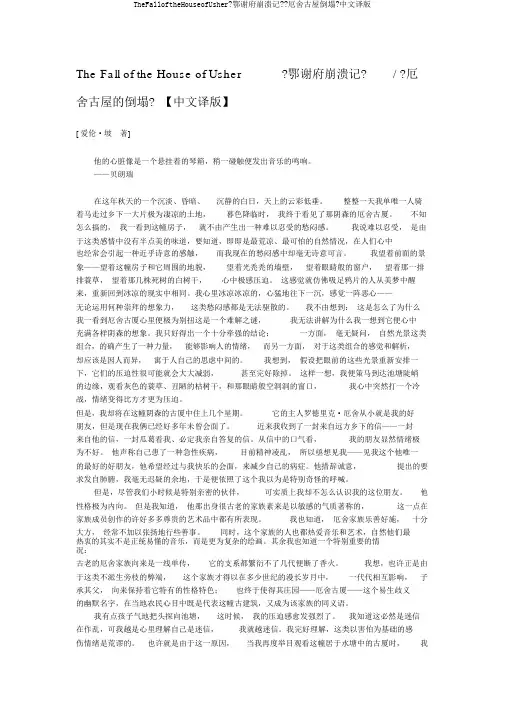
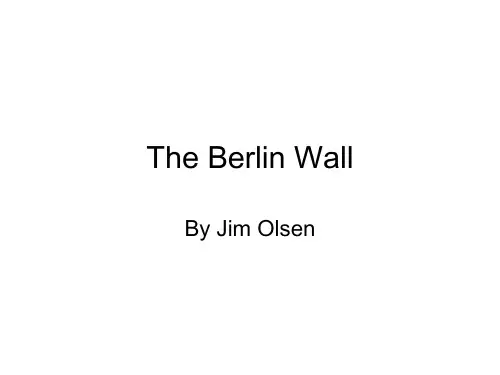
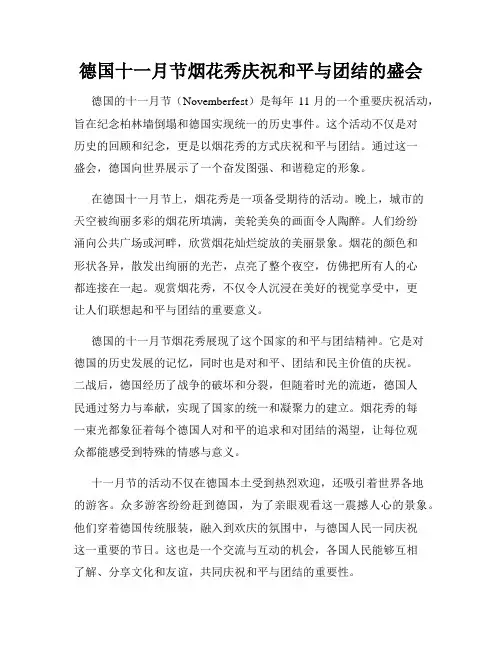
德国十一月节烟花秀庆祝和平与团结的盛会德国的十一月节(Novemberfest)是每年11月的一个重要庆祝活动,旨在纪念柏林墙倒塌和德国实现统一的历史事件。
这个活动不仅是对历史的回顾和纪念,更是以烟花秀的方式庆祝和平与团结。
通过这一盛会,德国向世界展示了一个奋发图强、和谐稳定的形象。
在德国十一月节上,烟花秀是一项备受期待的活动。
晚上,城市的天空被绚丽多彩的烟花所填满,美轮美奂的画面令人陶醉。
人们纷纷涌向公共广场或河畔,欣赏烟花灿烂绽放的美丽景象。
烟花的颜色和形状各异,散发出绚丽的光芒,点亮了整个夜空,仿佛把所有人的心都连接在一起。
观赏烟花秀,不仅令人沉浸在美好的视觉享受中,更让人们联想起和平与团结的重要意义。
德国的十一月节烟花秀展现了这个国家的和平与团结精神。
它是对德国的历史发展的记忆,同时也是对和平、团结和民主价值的庆祝。
二战后,德国经历了战争的破坏和分裂,但随着时光的流逝,德国人民通过努力与奉献,实现了国家的统一和凝聚力的建立。
烟花秀的每一束光都象征着每个德国人对和平的追求和对团结的渴望,让每位观众都能感受到特殊的情感与意义。
十一月节的活动不仅在德国本土受到热烈欢迎,还吸引着世界各地的游客。
众多游客纷纷赶到德国,为了亲眼观看这一震撼人心的景象。
他们穿着德国传统服装,融入到欢庆的氛围中,与德国人民一同庆祝这一重要的节日。
这也是一个交流与互动的机会,各国人民能够互相了解、分享文化和友谊,共同庆祝和平与团结的重要性。
除了烟花秀,德国的十一月节还包括各种文化表演、音乐会和美食节。
这些活动的举办,为人们提供了更多的机会,深入了解德国的传统和社会价值观。
人们可以欣赏到德国独特的音乐和舞蹈表演,品尝到各种美味的德国传统菜肴。
这一系列活动的举办,不仅增加了乐趣,也丰富了观众的文化体验。
德国的十一月节烟花秀庆祝和平与团结的盛会,不仅仅是为了庆祝历史的里程碑,更体现了德国人民对和平与团结的珍视和追求。
通过这场盛会,人们可以感受到德国民众的团结一致和对和平的热爱。
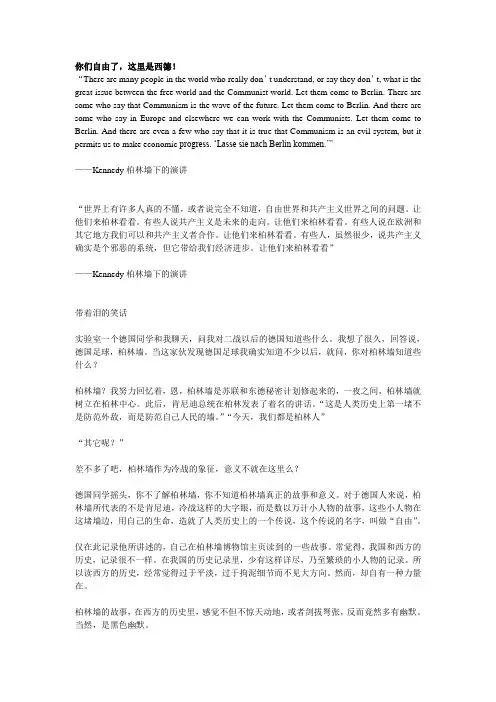
你们自由了,这里是西德!“There are many people in the world who really don’t understand, or say they don’t, what is the great issue between the free world and the Communist world. Let them come to Berlin. There are some who say that Communism is the wave of the future. Let them come to Berlin. And there are some who say in Europe and elsewhere we can work with the Communists. Let them come to Berlin. And there are even a few who say that it is true that Communism is an evil system, but it permits us to make economic progress. ‘Lasse sie nach Berlin kommen.’”——Kennedy柏林墙下的演讲“世界上有许多人真的不懂,或者说完全不知道,自由世界和共产主义世界之间的问题。
让他们来柏林看看。
有些人说共产主义是未来的走向。
让他们来柏林看看。
有些人说在欧洲和其它地方我们可以和共产主义者合作。
让他们来柏林看看。
有些人,虽然很少,说共产主义确实是个邪恶的系统,但它带给我们经济进步。
让他们来柏林看看”——Kennedy柏林墙下的演讲带着泪的笑话实验室一个德国同学和我聊天,问我对二战以后的德国知道些什么。
我想了很久,回答说,德国足球,柏林墙。
当这家伙发现德国足球我确实知道不少以后,就问,你对柏林墙知道些什么?柏林墙?我努力回忆着,恩,柏林墙是苏联和东德秘密计划修起来的,一夜之间,柏林墙就树立在柏林中心。
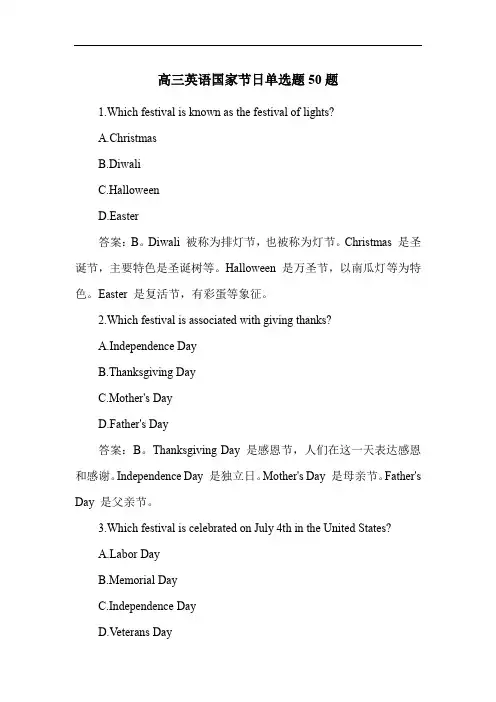
高三英语国家节日单选题50题1.Which festival is known as the festival of lights?A.ChristmasB.DiwaliC.HalloweenD.Easter答案:B。
Diwali 被称为排灯节,也被称为灯节。
Christmas 是圣诞节,主要特色是圣诞树等。
Halloween 是万圣节,以南瓜灯等为特色。
Easter 是复活节,有彩蛋等象征。
2.Which festival is associated with giving thanks?A.Independence DayB.Thanksgiving DayC.Mother's DayD.Father's Day答案:B。
Thanksgiving Day 是感恩节,人们在这一天表达感恩和感谢。
Independence Day 是独立日。
Mother's Day 是母亲节。
Father's Day 是父亲节。
3.Which festival is celebrated on July 4th in the United States?bor DayB.Memorial DayC.Independence DayD.Veterans Day答案:C。
美国在7 月 4 日庆祝Independence Day 独立日。
Labor Day 是劳动节。
Memorial Day 是阵亡将士纪念日。
Veterans Day 是退伍军人节。
4.Which festival is known for trick-or-treating?A.ChristmasB.DiwaliC.HalloweenD.Easter答案:C。
Halloween 万圣节以trick-or-treating( 不给糖就捣蛋)为特色。
Christmas 是圣诞节。
Diwali 是排灯节。
Easter 是复活节。

柏林广场a1词汇柏林广场(Berlin Platz)是德国柏林市中心的一个广场,位于勃兰登堡门(Brandenburg Gate)附近。
以下是与柏林广场(Berlin Platz)相关的一些词汇:1. 勃兰登堡门(Brandenburg Gate):柏林最著名的地标之一,建于18世纪末,是柏林墙倒塌后的象征性地点之一。
2. 雾化者纪念碑(Memorial to the Murdered Jews of Europe):位于柏林广场附近的一座纪念碑,用以纪念欧洲大屠杀期间遇难的犹太人。
3. 黑红金旗(Black-Red-Gold flag):德国国旗的颜色,黑色、红色和金色,常常在柏林广场附近的建筑物上飘扬。
4. 柏林墙(Berlin Wall):柏林广场曾是东西柏林分界线的一部分,柏林墙曾经将东西柏林分隔开来,现在已经拆除,但在柏林广场附近仍然可以看到一小段保留下来的墙体。
5. 德国国会大厦(Reichstag):位于柏林广场附近的一座历史建筑,现在是德国联邦议会的所在地,有一个玻璃穹顶,供游客参观。
6. 大使馆区(Embassy district):柏林广场附近有许多国家的大使馆,形成了一个国际大使馆区。
7. 柏林大教堂(Berlin Cathedral):位于柏林广场附近的一座新哥特式教堂,是柏林最重要的宗教建筑之一。
8. 德意志历史博物馆(German Historical Museum):位于柏林广场附近的一座博物馆,展示了德国历史的各个方面。
9. 联邦总统府(Bellevue Palace):位于柏林广场附近的德国总统的官邸。
10. 勃兰登堡大学(Humboldt University of Berlin):位于柏林广场附近的一所著名大学,是德国最古老的大学之一。
以上是柏林广场(Berlin Platz)相关的一些词汇,希望对您有帮助!。
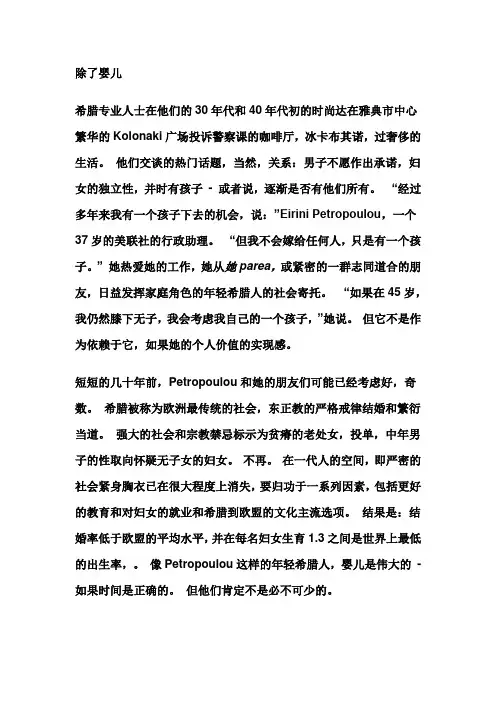
除了婴儿希腊专业人士在他们的30年代和40年代初的时尚达在雅典市中心繁华的Kolonaki广场投诉警察课的咖啡厅,冰卡布其诺,过奢侈的生活。
他们交谈的热门话题,当然,关系:男子不愿作出承诺,妇女的独立性,并时有孩子- 或者说,逐渐是否有他们所有。
“经过多年来我有一个孩子下去的机会,说:”Eirini Petropoulou,一个37岁的美联社的行政助理。
“但我不会嫁给任何人,只是有一个孩子。
”她热爱她的工作,她从她parea,或紧密的一群志同道合的朋友,日益发挥家庭角色的年轻希腊人的社会寄托。
“如果在45岁,我仍然膝下无子,我会考虑我自己的一个孩子,”她说。
但它不是作为依赖于它,如果她的个人价值的实现感。
短短的几十年前,Petropoulou和她的朋友们可能已经考虑好,奇数。
希腊被称为欧洲最传统的社会,东正教的严格戒律结婚和繁衍当道。
强大的社会和宗教禁忌标示为贫瘠的老处女,投单,中年男子的性取向怀疑无子女的妇女。
不再。
在一代人的空间,即严密的社会紧身胸衣已在很大程度上消失,要归功于一系列因素,包括更好的教育和对妇女的就业和希腊到欧盟的文化主流选项。
结果是:结婚率低于欧盟的平均水平,并在每名妇女生育1.3之间是世界上最低的出生率,。
像Petropoulou这样的年轻希腊人,婴儿是伟大的- 如果时间是正确的。
但他们肯定不是必不可少的。
在希腊,在世界上许多,让孩子们不再是一个之间的人口增长大片。
“以前从未有过生育的为妇女和男性在许多社会中的合法的选择,说:”凯瑟琳哈基姆,研究在伦敦经济学院的现象。
在瑞士,新加坡,加拿大和韩国的完全不同的国家发生了快速转变,年轻人延长推迟,直到他们到30多岁,甚至40年代及以后的儿童,他们的孩子免费成年。
一个越来越大的份额是结束了没有儿童。
在德国西部的终身无子女已经达到30%受过大学教育的妇女,并迅速跻身低下阶层的男性上升。
在英国,其余无子女的妇女人数在20年增加了一倍。
英文作文:Title: The Significance of the Fall of the Berlin WallOne of the most significant historical events in the 20th century was the fall of the Berlin Wall. It occurred on November 9, 1989, marking the end of the Cold War era and the beginning of a new era of reunification and cooperation.The Berlin Wall, which was built in 1961, had divided the city of Berlin into two parts: East Berlin, controlled by the Communist regime of the Soviet Union, and West Berlin, which was under the democratic government of West Germany. For almost three decades, this wall served as a symbol of oppression, division, and the Cold War conflict between the East and the West.However, on that fateful night in 1989, the people of East Berlin, led by brave individuals, began to chip away at the wall, using whatever tools they could find. Soon, the entire city was engulfed in a celebration as the wall came down, symbolizing the end of the Communist regime and the restoration of freedom and unity.The fall of the Berlin Wall not only signified the end of the Cold War but also marked a shift in global politics. It heralded a new era of cooperation and understanding between different political systems and ideologies. The reunification of Germany, which followed shortly after, further strengthened the idea of peace and unity.In conclusion, the fall of the Berlin Wall was a momentous event that changed the course of history. It reminded us that, with courage, perseverance, and a commitment to freedom and unity, we can overcome any obstacle and bring about positive change in the world.中文翻译:标题:柏林墙的倒塌的意义20世纪最重大的历史事件之一便是柏林墙的倒塌。
The fall of the WallToday we celebrate the bi-decennial of the demolition of the Berlin Wall - the concrete barrier erected by the then German Democratic Republic (GDR) (East Germany) that completely encircled the city of West Berlin, separating it from East Germany, including East Berlin.The Wall included guard towers placed along large concrete walls, which circumscribed a wide area (later known as the "death strip") that contained anti-vehicle trenches, "fakir beds" and other defenses. The separate and much longer inner German Border (the IGB) demarcated the border between East and West Germany. Both borders came to symbolize the Iron Curtain between Western Europe and the Eastern Bloc.Prior to the Wall's erection, 3.5 million East Germans had avoided Eastern Bloc emigration restrictions and escaped into West Germany, many over the border between East and West Berlin. During its existence from 1961 to 1989, the Wall stopped almost all such emigration and separated the GDR from West Berlin for more than a quarter of a century.[1] After its erection, around 5,000 people attempted to escape over the wall, with estimates of the resulting death toll varying between around 100 and 200.During a revolutionary wave sweeping across the Eastern Bloc, the East German government announced on November 9, 1989, after several weeks of civil unrest, that all GDR citizens could visit West Germany and West Berlin. Crowds of East Germans climbed onto andcrossed the wall, joined by West Germans on the other side in a celebratory atmosphere. Over the next few weeks, parts of the wall were chipped away by a euphoric public and by souvenir hunters; industrial equipment was later used to remove almost all of the rest. The fall of the Berlin Wall paved the way for German reunification, which was formally concluded on October 3, 1990.。
柏林墙自由.....XuY/100329柏林墙20年前,1989年11月9日晚上,亲民主的抗议活动进行了几个星期,东德当局突然开放与西德的边界。
经过28年象囚犯一样生活,欣喜的东德人涌向各检查站,冲过手足无措警卫,许多人含泪投向欢迎他们到来的西德人的怀抱。
2009年11月9日数千名德国人和世界各国领导人聚会庆祝“Mauerfall” (Mauerfall是一个专有名词, 专指1989 年11 月9日柏林墙倒塌这一历史事件)、柏林墙拆除、德国重新统一,并纪念这些年里为试图越过边界而死去的大约100-200人。
1989年11月12日一名男子在锤击柏林墙,柏林墙作为东德和西德之间的边界和屏障,28年后被拆除1989年11月10日士兵们站在勃兰登堡门前的柏林墙上。
1989年11月11日上午波茨坦广场的柏林墙开放。
1989年11月11日在波茨坦广场士兵阻止群众拆除柏林墙的部分墙体。
1989年11月10日东柏林人在爬柏林墙时得到了西柏林人的帮助之手。
1989年11月11日勃兰登堡门前东柏林警卫站立在柏林墙之上。
1989年11月10日边界被打开之后,查理检查站附近民主德国边防警察拒绝与一名从东部边界围栏那边伸手出来的柏林人握手。
1989年11月11号在波茨坦广场,一只马戏熊用它的后腿和它的训兽师一起穿越一段柏林墙到达西柏林。
1989年11月11日勃兰登堡门前,东德边防军通过柏林墙的缺口检查被示威者拉倒的一段墙。
1989年11月10日东德居民乘汽车越过他们的查理检查站进入西柏林时受到西柏林人的热烈欢迎,东德政府开放柏林墙后成千上万的东德人赶赴西柏林。
1989年11月10日勃兰登堡门前,西柏林市民连续在柏林墙上守夜。
1999年11月1日和上一张照片相同位置的画面是,通过勃兰登堡门来往的汽车。
1989年11月10日德国国会大厦(左)与柏林墙20年后的2009年10月20日与前一张照片相同位置,德国国会大厦(左),墙已经没有了。
推倒柏林墙英文讲演稿Remarks at the Brandenburg GateWest Berlin, GermanyJune 12, 1987President Ronald Reagon:Thank you. Thank you, very much.Chancellor Kohl, Governing Mayor Diepgen, ladies and gentlemen: Twenty four years ago, President John F. Kennedy visited Berlin, and speaking to the people of this city and the world at the city hall. Well since then two other presidents have come, each in his turn to Berlin. And today, I, myself, make my second visit to your city.We come to Berlin, we American Pres idents, because it’s our duty to speak in this place of freedom. But I must confess, we’re drawn here by other things as well; by the feeling of history in this city — more than 500 years older than our own nation; by the beauty of the Grunewald and the Tiergarten; most of all, by your courage and determination. Perhaps the composer, Paul Linke, understood something about American Presidents. You see, like so many Presidents before me, I come here today because wherever I go, whatever I do: “Ich hab noch ei nen Koffer in Berlin” [I still have a suitcase in Berlin.]Our gathering today is being broadcast throughout Western Europe and North America. I understand that it is being seen and heard as well in the East. To those listening throughout Eastern Europe, I extend my warmest greetings and the good will of the American people. To those listening in East Berlin, a special word: Although I cannot be with you, I address my remarks to you just as surely as to those standing here before me. For I join you, as I join your fellow countrymen in the West, in this firm, this unalterable belief: Es gibt nur ein Berlin. [There is only one Berlin.]Behind me stands a wall that encircles the free sectors of this city, part of a vast system of barriers that divides the entire continent of Europe. From the Baltic South, those barriers cut across Germany in a gash of barbed wire, concrete, dog runs, and guard towers. Farther south, there may be no visible, no obvious wall. But there remain armed guards and checkpoints all the same — still a restriction on the right to travel, still an instrument to impose upon ordinary men and women the will of a totalitarian state.Yet, it is here in Berlin where the wall emerges most clearly; here, cutting across your city, where the news photo and the television screen have imprinted this brutal division of a continent upon the mind of the world.Standing before the Brandenburg Gate, every man is a German separated from his fellow men.Every man is a Berliner, forced to look upon a scar.Presi dent Von Weizsäcker has said, “The German question is open as long as the Brandenburg Gate is closed.” Well today — today I say: As long as this gate is closed, as long as this scar of a wall is permitted to stand, it is not the German question alone that remains open, but the question of freedom for all mankind.Yet, I do not come here to lament. For I find in Berlin a message of hope, even in the shadow of this wall, a message of triumph.In this season of spring in 1945, the people of Berlin emerged from their air-raid shelters to find devastation. Thousands of miles away, the people of the United States reached out to help. And in 1947 Secretary of State —as you’ve been told — George Marshall announced the creation of what would become known as the Marshall Plan. Speaking precisely 40 years ago this month, he said: “Our policy is directed not against any country or doctrine, but against hunger, poverty, desperation, and chaos.”In the Reichstag a few moments ago, I saw a display commemorating this 40th anniversary of the Marshall Plan. I was struckby a sign — the sign on a burnt-out, gutted structure that was being rebuilt. I understand that Berliners of my own generation can remember seeing signs like it dotted throughout the western sectors of the city. The sign read simply: “The Marshall Plan is helping here to strengthen the free world.” A strong, free world in the West — that dream became real. Japan rose from ruin to become an economic giant. Italy, France, Belgium — virtually every nation in Western Europe saw political and economic rebirth; the European Community was founded.In West Germany and here in Berlin, there took place an economic miracle, the Wirtschaftswunder. Adenauer, Erhard, Reuter, and other leaders understood the practical importance of liberty — that just as truth can flourish only when the journalist is given freedom of speech, so prosperity can come about only when the farmer and businessman enjoy economic freedom. The German leaders — the German leaders reduced tariffs, expanded free trade, lowered taxes. From 1950 to 1960 alone, the standard of living in West Germany and Berlin doubled.Where four decades ago there was rubble, today in West Berlin there is the greatest industrial output of any city in Germany: busy office blocks, fine homes and apartments, proud avenues, and the spreading lawns of parkland. Where a city’s culture seemed to have been destroyed, today there are two great universities, orchestras andan opera, countless theaters, and museums. Where there was want,to day there’s abundance — food, clothing, automobiles — the wonderful goods of the Kudamm.¹ From devastation, from utter ruin, you Berliners have, in freedom, rebuilt a city that once again ranks as one of the greatest on earth. Now the Soviets may have had other plans. But my friends, there were a few things the Soviets didn’t count on: Berliner Herz, Berliner Humor, ja, und Berliner Schnauze. [Berliner heart, Berliner humor, yes, and a Berliner Schnauze.²]In the 1950s —In the 1950s Khrushchev predicted: “We will bury you.”But in the West today, we see a free world that has achieved a level of prosperity and well-being unprecedented in all human history. In the Communist world, we see failure, technological backwardness, declining standards of health, even want of the most basic kind — too little food. Even today, the Soviet Union still cannot feed itself. After these four decades, then, there stands before the entire world one great and inescapable conclusion: Freedom leads to prosperity. Freedom replaces the ancient hatreds among the nations with comity and peace. Freedom is the victor.And now — now the Soviets themselves may, in a limited way, be coming to understand the importance of freedom. We hear much fromMoscow about a new policy of reform and openness. Some political prisoners have been released. Certain foreign news broadcasts are no longer being jammed. Some economic enterprises have been permitted to operate with greater freedom from state control.Are these the beginnings of profound changes in the Soviet state? Or are they token gestures intended to raise false hopes in the West, or to strengthen the Soviet system without changing it? We welcome change and openness; for we believe that freedom and security go together, that the advance of human liberty — the advance of human liberty can only strengthen the cause of world peace.There is one sign the Soviets can make that would be unmistakable, that would advance dramatically the cause of freedom and peace. General Secretary Gorbachev, if you seek peace, if you seek prosperity for the Soviet Union and Eastern Europe, if you seek liberalization: Come here to this gate.Mr. Gorbachev, open this gate.Mr. Gorbachev — Mr. Gorbachev, tear down this wall!I understand the fear of war and the pain of division that afflict this continent, and I pledge to you my country’s efforts to help overcome these burdens. To be sure, we in the West must resist Soviet expansion.So, we must maintain defenses of unassailable strength. Yet we seek peace; so we must strive to reduce arms on both sides.Beginning 10 years ago, the Soviets challenged the Western alliance with a grave new threat, hundreds of new and more deadly SS-20 nuclear missiles capable of striking every capital in Europe. The Western alliance responded by committing itself to a counter-deployment (unless the Soviets agreed to negotiate a better solution) — namely, the elimination of such weapons on both sides. For many months, the Soviets refused to bargain in earnestness. As the alliance, in turn, prepared to go forward with its counter-deployment, there were difficult days, days of protests like those during my 1982 visit to this city; and the Soviets later walked away from the table.But through it all, the alliance held firm. And I invite those who protested then — I invite those who protest today — to mark this fact: Because we remained strong, the Soviets came back to the table. Because we remained strong, today we have within reach the possibility, not merely of limiting the growth of arms, but of eliminating, for the first time, an entire class of nuclear weapons from the face of the earth.As I speak, NATO ministers are meeting in Iceland to review the progress of our proposals for eliminating these weapons. At the talks in Geneva, we have also proposed deep cuts in strategic offensiveweapons. And the Western allies have likewise made far-reaching proposals to reduce the danger of conventional war and to place a total ban on chemical weapons.While we pursue these arms reductions, I pledge to you that we will maintain the capacity to deter Soviet aggression at any level at which it might occur. And in cooperation with many of our allies, the United States is pursuing the Strategic Defense Initiative — research to base deterrence not on the threat of offensive retaliation, but on defenses that truly defend; on systems, in short, that will not target populations, but shield them. By these means we seek to increase the safety of Europe and all the world. But we must remember a crucial fact: East and West do not mistrust each other because we are armed; we are armed because we mistrust each other. And our differences are not about weapons but about liberty. When President Kennedy spoke at the City Hall those 24 years ago, freedom was encircled; Berlin was under siege. And today, despite all the pressures upon this city, Berlin stands secure in its liberty. And freedom itself is transforming the globe.In the Philippines, in South and Central America, democracy has been given a rebirth. Throughout the Pacific, free markets are working miracle after miracle of economic growth. In the industrialized nations,a technological revolution is taking place, a revolution marked by rapid, dramatic advances in computers and telecommunications.In Europe, only one nation and those it controls refuse to join the community of freedom. Yet in this age of redoubled economic growth, of information and innovation, the Soviet Union faces a choice: It must make fundamental changes, or it will become obsolete.Today, thus, represents a moment of hope. We in the West stand ready to cooperate with the East to promote true openness, to break down barriers that separate people, to create a safer, freer world. And surely there is no better place than Berlin, the meeting place of East and West, to make a start.Free people of Berlin: Today, as in the past, the United States stands for the strict observance and full implementation of all parts of the Four Power Agreement of 1971. Let us use this occasion, the 750th anniversary of this city, to usher in a new era, to seek a still fuller, richer life for the Berlin of the future. Together, let us maintain and develop the ties between the Federal Republic and the Western sectors of Berlin, which is permitted by the 1971 agreement.And I invite Mr. Gorbachev: Let us work to bring the Eastern and Western parts of the city closer together, so that all the inhabitants ofall Berlin can enjoy the benefits that come with life in one of the great cities of the world.To open Berlin still further to all Europe, East and West, let us expand the vital air access to this city, finding ways of making commercial air service to Berlin more convenient, more comfortable, and more economical. We look to the day when West Berlin can become one of the chief aviation hubs in all central Europe.With — With our French — With our French and British partners, the United States is prepared to help bring international meetings to Berlin. It would be only fitting for Berlin to serve as the site of United Nations meetings, or world conferences on human rights and arms control, or other issues that call for international cooperation.There is no better way to establish hope for the future than to enlighten young minds, and we would be honored to sponsor summer youth exchanges, cultural events, and other programs for young Berliners from the East. Our French and British friends, I’m certain, will do the same. And it’s my hope that an authority can be found in East Berlin to sponsor visits from young people of the Western sectors.One final proposal, one close to my heart: Sport represents a source of enjoyment and ennoblement, and you may have noted that the Republic of Korea — South Korea — has offered to permit certainevents of the 1988 Olympics to take place in the North. International sports competitions of all kinds could take place in both parts of this city. And what better way to demonstrate to the world the openness of this city than to offer in some future year to hold the Olympic games here in Berlin, East and West.In these four decades, as I have said, you Berliners have built a great city. You’ve done so in spite of threats — the Soviet attempts to impose the East-mark, the blockade. Today the city thrives in spite of the challenges implicit in the very presence of this wall. What keeps you here? Certainly there’s a great deal to be said for your fortitude, for your defiant courage. But I believe there’s something deeper, something that involves Berlin’s whole look and feel and way of life —not mere sentiment. No one could live long in Berlin without being completely disabused of illusions. Something, instead, that has seen the difficulties of life in Berlin but chose to accept them, that continues to build this good and proud city in contrast to a surrounding totalitarian presence, that refuses to release human energies or aspirations, something that speaks with a powerful voice of affirmation, that says “yes” to this city, yes to the future, yes to freedom. In a word, I would submit that what keeps you in Berlin —is “love.”Love both profound and abiding.Perhaps this gets to the root of the matter, to the most fundamental distinction of all between East and West. The totalitarian world produces backwardness because it does such violence to the spirit, thwarting the human impulse to create, to enjoy, to worship. The totalitarian world finds even symbols of love and of worship an affront.Years ago, before the East Germans began rebuilding their churches, they erected a secular structure: the television tower at Alexander Platz. Virtually ever since, the authorities have been working to correct what they view as the tower’s one major flaw: treating the glass sphere at the top with paints and chemicals of every kind. Yet even today when the sun strikes that sphere, that sphere that towers over all Berlin, the light makes the sign of the cross. There in Berlin, like the city itself, symbols of love, symbols of worship, cannot be suppressed.As I looked out a moment ago from the Reichstag, that embodiment of German unity, I noticed words crudely spray-painted upon the wall, perhaps by a young Berliner (quote):“This wall will fall. Beliefs become reality.”Yes, across Europe, this wall will fall, for it cannot withstand faith; it cannot withstand truth. The wall cannot withstand freedom.And I would like, before I close, to say one word. I have read, and I have been questioned since I’ve been her e about certain demonstrations against my coming. And I would like to say just one thing, and to those who demonstrate so. I wonder if they have ever asked themselves that if they should have the kind of government they apparently seek, no one would ever b e able to do what they’re doing again.Thank you and God bless you all. Thank you.。
The fall of the Wall
Today we celebrate the bi-decennial of the demolition of the Berlin Wall - the concrete barrier erected by the then German Democratic Republic (GDR) (East Germany) that completely encircled the city of West Berlin, separating it from East Germany, including East Berlin.
The Wall included guard towers placed along large concrete walls, which circumscribed a wide area (later known as the "death strip") that contained anti-vehicle trenches, "fakir beds" and other defenses. The separate and much longer inner German Border (the IGB) demarcated the border between East and West Germany. Both borders came to symbolize the Iron Curtain between Western Europe and the Eastern Bloc.
Prior to the Wall's erection, 3.5 million East Germans had avoided Eastern Bloc emigration restrictions and escaped into West Germany, many over the border between East and West Berlin. During its existence from 1961 to 1989, the Wall stopped almost all such emigration and separated the GDR from West Berlin for more than a quarter of a century.[1] After its erection, around 5,000 people attempted to escape over the wall, with estimates of the resulting death toll varying between around 100 and 200.
During a revolutionary wave sweeping across the Eastern Bloc, the East German government announced on November 9, 1989, after several weeks of civil unrest, that all GDR citizens could visit West Germany and West Berlin. Crowds of East Germans climbed onto and
crossed the wall, joined by West Germans on the other side in a celebratory atmosphere. Over the next few weeks, parts of the wall were chipped away by a euphoric public and by souvenir hunters; industrial equipment was later used to remove almost all of the rest. The fall of the Berlin Wall paved the way for German reunification, which was formally concluded on October 3, 1990.。